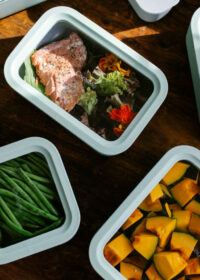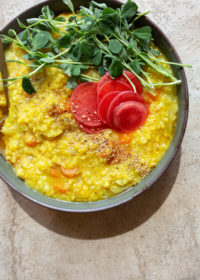Recipes: Autumn Kitchari + Cilantro Coconut Chutney

Twice a year, every spring and fall, I take a week or two to cleanse my body and prepare for a new season. This spring, I did a 10-day raw juice and broth fast paired with some deep healing herbs. When the weather is warm after the equinox, I like to do my longer juice fasts as a way of releasing stagnant energy, reconnecting with myself from a place of clarity, and setting new intentions for the coming season. But this year, the cooler evening weather has me craving warming, cooked foods and my body opted to add more meals alongside my juice routine.
Honoring this request my body made, I signed up for Maria Lalita’s Ayurvedic Fall Cleanse. Maria is an incredible functional yoga therapist and an Ayurvedic practitioner. Each spring and fall she leads this cleanse, both locally in Tuscon and online through webinars and downloadable Ebooks. You can find more info on Maria and her programs here.
I’m 11 days into the program now, with an 8 day pre-cleanse period of eliminating certain foods, establishing meal times and restorative routines, and taking time to rest. Today, I’m on Day 3 of the official cleansing period, sticking strictly to a Kitchari diet with a few homemade chutneys and several purposeful Ayurvedic herbs, along with plenty of water and cleansing teas.

Kitchari, a soupy porridge of mung beans, rice and spices, is a healing dish often prescribed by Ayurvedic physicians alongside the traditional panchakarma practice, a rejuvenative series of natural holistic treatments that cleanses toxins stored in bodily tissues as it restores systemic balance.
The Ayurvedic system believes that all healing begins with the digestive tract. Consuming kitchari alone can provide rest to our digestive systems from having to break down processed foods, while nourishing our bodies with essential vitamins, minerals and amino acids. It is said to nourish all three bodytypes (doshas). The combination of beans and rice makes for a complete protein, while the spices stoke the fires of Agni, our innate digestive fire that becomes weakened as a result of poor food combining and constant grazing. The goal of this entire cleanse is to bring balance to our bodies and boost our digestion by consuming 2-3 small, easily digestible meals of kitchari during optimal times of the day and allowing plenty of time for rest and restorative routines.
Kitchari is good for all bodtypes – for the cold, dry and spacey vata types, the warm soup is grounding; for fiery pitta types, its spices are calming; and for chilly, slow kapha, it provides healing warmth. However, with a few minor tweaks and additions, if you know your constitution you can make these adjustments for a more dosha specific meal. For example, if you have a kapha imbalance, the water element that tends towards having excess mucous and sluggish digestion, it’s best to omit the extra ghee or coconut oil. If you have a pitta imbalance, the fire element that tends towards overheating and loose bowels, avoid adding too many heating spices like ginger, mustard seed or peppers. If you’d like to find out your overall dosha (prakriti) and your current tendencies (vikriti) you can take this two part quiz here.

For this recipe specifically, I focused on using herbs that would balance my Vata constitution – especially because we are in Fall now, the time of the year characterized by vata. Avoiding raw foods in the evenings, focusing on warming, soupy cooked foods and heating spices help keep us spacey vata types from floating off into the ether on those cold, blustery fall days. If you take the quiz and find you have a vata imbalance, even though your primary constitution may tend towards pitta or kapha, then you might consider trying this recipe this time of the year. I’ve really boosted the spices up quite a bit in this recipe, because I can never get too much spice in my life! But if you find yourself craving a more watered down version of this, you can reduce the spice quantities by half.
So many wonderful options with this recipe! It doesn’t have to be eaten in a cleanse setting either, it’s a good year round recipe that you can eat whenever you need to give your digestion a nice break and crave something comforting. Top it with this nutrient-rich, detoxifying cilantro coconut chutney and you have yourself a seriously satisfying meal.

CILANTRO COCONUT CHUTNEY
2 bunches cilantro, stems removed
½ cup lemon juice
½ cup water
1 cup shredded dried coconut (unsweetened)
3 in. fresh ginger
1 tbsp raw honey
1 tsp Himalayan pink salt
Remove the stems and wash the cilantro well. Add cilantro, lemon juice and water to a high-speed blender. Pulse until well combined. Add the remaining ingredients and blend into a paste. Store in an airtight glass container for up to one week.
Makes 16-20oz
**Recipe adapted from Lalita’s Ayurvedic Cleanses Ebook.

FALL KITCHARI
1 cup split mung beans (moong dal)
¾ cup basmati rice
2 pieces kombu
2 bay leaves
10-12 cups water
2 tbsp ghee (use coconut oil for vegan variation)
2 tbsp yellow mustard seed
2 tbsp coriander seeds
2 tbsp turmeric powder
2 tbsp ginger, fresh grated or powder
1 tbsp cumin seeds
1 tsp fennel seeds
1 tsp fenugreek seeds
½ tsp cinnamon
¼ tsp asafoetida
½ tsp Himalayan pink salt
Optional:
1 cup kale, chopped
1 cup zucchini, diced
2 carrots, diced
Combine the mung beans, rice, kombu and bay leaves in a large pot. Add 10 cups of water to start, or enough to cover mixture with 3-4 inches of water. Bring to a boil, then reduce heat to a simmer.
Then, heat a separate sauce pan. Add in your ghee or coconut oil, then stir in all your spices and heat gently on low to release the flavors – careful not to burn. Transfer spices into your pot of rice/dal, stir until well combined. Continue to cook on low for about 45 minutes. If adding vegetables to the mix, add after 30 minutes of cooking. Check occasionally and stir to make sure nothing sticks to the bottom of the pot. For very well cooked and soupy kitchari, add more water and continue to cook until desired consistency.
To serve, garnish with a squeeze of lime juice and a big dollop of cilantro chutney.
Makes 64-72oz
Variations for Pitta:
Avoid mustard seeds and ginger
Increase fennel seeds
Variations for Kapha:
Increase ginger
Add ¼ tsp clove powder and cardamom powder
Omit ghee/coconut oil
 [wpmenucart]
[wpmenucart] Living Ayurveda: Meal Planning Tips
Living Ayurveda: Meal Planning Tips  Recipes: My Favorite Kitchari Recipe + Ume Pickled Radishes
Recipes: My Favorite Kitchari Recipe + Ume Pickled Radishes  Interview: A Behind-the-Scenes Look at the Making of A Book
Interview: A Behind-the-Scenes Look at the Making of A Book 
I made this and have just now gotten around to commenting…. It was so delicious. I didn’t really use it as a full out cleanse as had just finished a 5 day juice cleanse but I ate it everyday and I think I will cleanse with it next time around.
Isn’t this the most satiating meal ever? It doesn’t have to be eaten as a mono-diet cleanse, it’s good anytime for a warming nourishing meal in the winter time. Congrats on completing a 5 day juice cleanse, I ran into Carla and she told me you had just done one! Hope you’re feeling fabulous
[…] been eager to share this recipe since my Ayurvedic cleanse after the fall equinox. It’s become one of my favorite morning rituals to warm my body up in […]
I love where this blog is headed! Hooray! Thanks for the new recipes!
Thank you, I’m so glad you enjoy the Vidya experience! Keep in touch!
The Cleansing Kitchari sounds absolutely fantastic! I have saved the link, and hopefully I will get around to making it in the neat future x
x
http://julesthenorweegie.blogspot.nl/
You’re going to love this kitchari, so warming and nourishing! And don’t be daunted by the long list of ingredients, it’s actually fairly quick and simple once everything in the pot. Enjoy!
Hi Claire, thanks for sharing this fantastic recipe I am on day 2 of a 6-day cleanse and feeling really good. I was curious about your use of whole beans and seeds rather than split and ground, as I have seen in other recipes. I enjoy the texture they impart, and am wondering if you had a dosha-specific reason for leaving them whole. I have enjoyed chewing them and tasting each unique flavor
I am on day 2 of a 6-day cleanse and feeling really good. I was curious about your use of whole beans and seeds rather than split and ground, as I have seen in other recipes. I enjoy the texture they impart, and am wondering if you had a dosha-specific reason for leaving them whole. I have enjoyed chewing them and tasting each unique flavor 
Hi Anna! I use whole seeds and grind them up slightly in my mortar and pestle to release the flavor. I find the whole seeds contain more flavor and potency for this slow-cooked stew recipe, and thus like to cook with them whole in my kitchari. And though not necessarily for doshic reasons, the process of chewing our food activates the digestive process, so perhaps in chewing these seeds more fully we promote better digestion of these stomach supporting spices. Good luck on your cleanse this week! Fall Blessings
[…] Kitchari with Cilantro Coconut Chutney from Vidya […]
[…] While I haven’t been using it as a detox/cleanse, I’ve been loving a simple, warming kitchari for lunches lately. Cilantro Coconut Chutney + Healing Kitchari (aryurvedic) […]
Hi Claire. I just finished making a big pot of your kitchari recipe and am currently eating a generous helping. I wasn’t expecting the astringent taste but after doing a little research, I understand that this is a huge health benefit. I wanted to use my pot of kitchari over the next few days to do a mono-diet cleanse but I read a few sources that says making it fresh every day is best and it loses it’s nutritional properties after reheating it. That does make sense but I wouldn’t use the microwave, just a gentle reheat on the stove. Will I still reap the benefits if I use the bulk batch I made over the next couple days? Thanks!
Hi Sara! Great question. It’s true, Ayurveda does not recommend leftovers. This is because food that is canned, frozen, or that has been sitting around for days can be known as Tamasic in nature. Our aim is to eat more fresh foods filled with life-force, prana, to create a more Sattvic state of being. However, knowing that we live in a modern world where sometimes cooking for every single meal is not possible, I recommend simply adding in fresh greens when reheating your kitchari to bring a little more prana into the dish. It certainly doesn’t lose it’s nutritional value after a day or two, and it’s wonderful you’re using a stove vs. a microwave, this also greatly helps it retain its more sattvic benefits. Enjoy your kitchari! I just finished 5 days of a my spring cleanse
I usually make a completely Satvik bare bones khichri- just rice, yellow moong dal, turmeric, ghee and cumin and sometimes a pinch of asafoetida. Kombu sounds like an interesting addition
[…] completed a 14-day Ayurvedic cleanse, where I focused on eating warming cooked foods and spices before following a strict kitchari diet for a week. It took a few days to adjust to eating more grain than I usually do, but once I made the shift I […]
Hi there! I came back to revisit this recipe, but it isn’t loading properly. Is it still visible somewhere else? I hope so!!
Hi Clarice! It looks like you visited in the middle of my website transition. Now that the new site is launched, let me know if you have any troubles accessing the kitchari post! It can searched for in the Journal page or under the Recipes tab under soups & stews.
Hello,
Are juice cleanses recommended in Ayurveda or for Vata-imbalances?